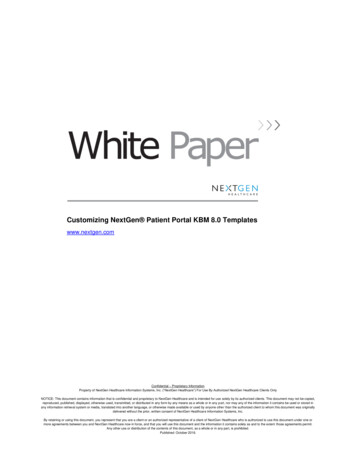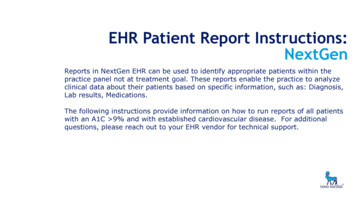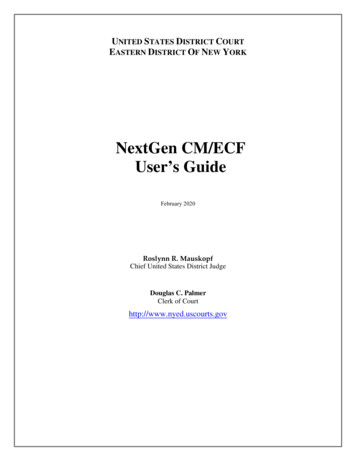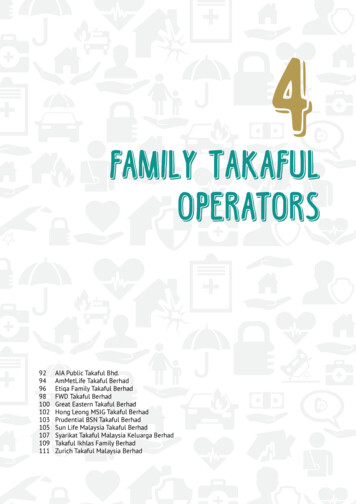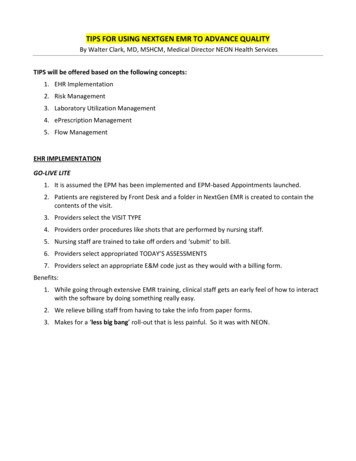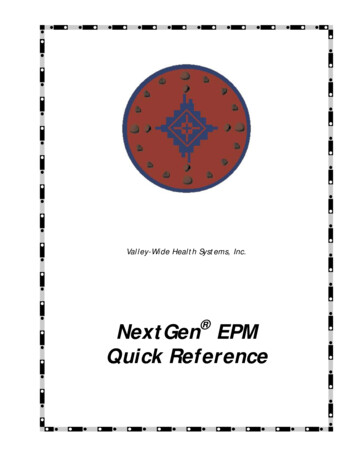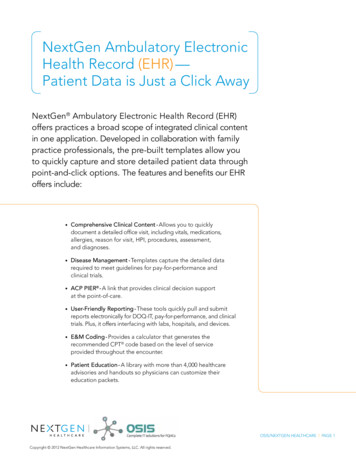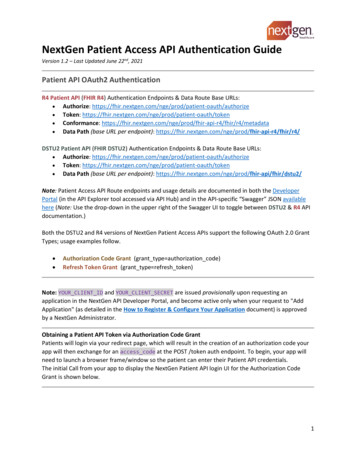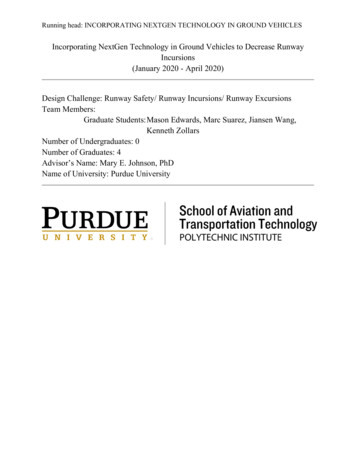
Transcription
Running head: INCORPORATING NEXTGEN TECHNOLOGY IN GROUND VEHICLESIncorporating NextGen Technology in Ground Vehicles to Decrease RunwayIncursions(January 2020 - April 2020)Design Challenge: Runway Safety/ Runway Incursions/ Runway ExcursionsTeam Members:Graduate Students: Mason Edwards, Marc Suarez, Jiansen Wang,Kenneth ZollarsNumber of Undergraduates: 0Number of Graduates: 4Advisor’s Name: Mary E. Johnson, PhDName of University: Purdue University
INCORPORATING NEXTGEN TECHNOLOGY IN GROUND VEHICLES1Executive SummaryRunway incursions are a significant safety issue for commercial aviation. The FederalAviation Agency (FAA) and other safety organizations have taken steps to promote mitigationstrategies and help reduce the severity of incursions. Airports consider runway incursions amajor issue as evidenced by the ACRP University Design Competition challenge categoryaddressing runway incursions. A thorough literature review was performed to better understandthe issue of runway incursions, their prevalence, and current mitigation technologies. One suchtechnology is ASDE-X. However, in its current state it does not address one of the significantcontributing factors: ground vehicle related runway incursions. This design team developed asolution to address this gap in technology for challenge topic F of “expanding the situationalawareness of pilots and ground operators on the airfield” in the Competition Guidelines.The design team identified three possible technologies that could mitigate groundvehicles as a contributing factor. The team ran through two iterations of comparison betweencurrently used technologies, basing judgement criteria off published documents from the FAAand personal experiences. The team decided to implement ASDE-X into ground vehicles by wayof a multifunction display. The team developed a technical description of how the units wouldfunction and then performed a sustainability analysis of the proposed solution.This analysis was performed via the EONS framework. The operational, economic,environmental, and social impacts of the solution were theorized and discussed. Additionally, theteam performed a risk-hazard assessment to determine possible issues with implementing thesystem. After reviewing the proposed design, the team believes that implementing ASDE-X intoairport ground vehicles can prove a viable method to combating runway incursions with a costbenefit ratio of 281:1.
INCORPORATING NEXTGEN TECHNOLOGY IN GROUND VEHICLES2Table of ContentsExecutive Summary .1Table of Contents .21. Problem Statement .32. Literature Review .42.1. Runway Incursions and Prevalence .42.2. Incursions and Ground Vehicles .42.3. State-of-the-art Technology: ASDE-X, RWSL, RAAS .62.4. NASA Runway Incursion Prevention System . .83. Problem Solving Approach . .93.1. Comparison between implementation of RAAS versus ASDE-X .143.2. Comparison of Different Implementations for ASDE-X .164. Technical Description of System .205. Safety Risk Assessment 236. Industry Interaction .257. Projected Impacts of Design .287.1. Cost-Benefit Analysis . 287.2. Sustainability Assessment .347.3. Fulfillment of ACRP Goals 378. Conclusion .38Appendices .39Appendix A .39Appendix B .40Appendix C .41Appendix D .42Appendix E .43Appendix F . .48
INCORPORATING NEXTGEN TECHNOLOGY IN GROUND VEHICLES1.3Problem StatementAccording to the International Civil Aviation Organization (ICAO) definition that theFederal Aviation Administration (FAA) (2015c) began to use in 2007, “a runway incursion isany occurrence at an airport involving the incorrect presence of an aircraft, vehicle, or person onthe protected area of a surface designated for the landing and take-off of aircraft” (para. 2).According to the FAA (2015c), in fiscal year 2013, towered airports reported a total of 1,241runway incursions which is an increase of 91 from fiscal year 2012. These same airports reporteda total of 1264 runway incursions in 2014, an increase of 23 from fiscal year 2013 (FAA, 2015c).There is solid evidence pointing towards an increasing trend in the occurrences of runwayincursions.According to the FAA (2014a), “Runway incursions are classified by the FAA into threecategories by their types: Operational Incidents, Pilot Deviations, and Vehicle /PedestrianDeviations.” Research reported in 2007 showed that 62% of runway incursions were caused bypilots and 35% due to air traffic controllers (Prinzel, 2007). More recently, in 2017 the FAAfound that over 20% of all runway incursions annually are caused by ground vehicle deviations(FAA, 2017). Such statistics point to human factors as a significant role in the cause of runwayincursions.To decrease both the impact and frequency of runway incursions, the FAA hasimplemented a variety of techniques and technologies. One of these pieces of technology is theASDE-X system. It uses multiple inputs from other navigation sources to allow ATC to createlive feed maps of surface and near airport movements of aircraft (FAA, 2014a). However, thistechnology (and by extension many of the FAA efforts) focus mainly on the Air Traffic Control(ATC) side of the operation and not on the personnel working in the high traffic ground areas.
INCORPORATING NEXTGEN TECHNOLOGY IN GROUND VEHICLES4Many navigation systems for traffic management are primarily designed for the air trafficcontrollers’ use. This information has inspired the team to incorporate aspects of ASDE-X intothe ground vehicles of airport operations to provide increased situational awareness for personneland help reduce the frequency of runway incursions due to Vehicle/Pedestrian Deviations.2.Literature Review2.1.Runway Incursions and PrevalenceDating as far back as the early 2000s, runway incursions have been a significant factoraffecting the safety of the aviation industry (FAA, 2005a). As the FAA stated, “Although theyare not a new problem, with increasing air traffic, runway incursions have been on the rise”(FAA, 2012a, p. 2). Prior to 2011, the number of reported incidents had slightly fluctuated, butincreased slowly. The number of FAA reported runway incursion related incidents had trendedupwards quickly between the years of 2012 and 2016, going from nearly 50 cases to almost 80cases between the respective years (Werfelman, 2017). According to this same report, the fiscalyear of 2017 had nearly 1,341 FAA reported runway incursions, of which the FAA places eightin the most severe categories (FAA, 2014b).2.2.Incursions and Ground VehiclesAccording to the FAA’s 2015-2017 National Runway Safety Plan, the key metrics ofrunway safety are frequency, severity, and type (FAA, n.d.b). Frequency is measured by numberof events, and type is broken down to the three aforementioned “causes”. Severity is measuredon a scale of categories, from A (most severe) to D (least severe) (FAA, 2015a). Through thecombined implementation of incursion mitigating technologies, the number of category A and Bincursions has dropped significantly from 67 in 2000 to only 8 in 2017 (of which only three
INCORPORATING NEXTGEN TECHNOLOGY IN GROUND VEHICLES5involved commercial aircraft) (FAA, 2018a). Yet, while the severity of incursions has beenreduced, the overall frequency of incursions per operations continues to rise (FAA, 2020a).Integral to this issue is the recurrence of one specific type of incursion: Vehicle/PedestrianDeviation (VPD).VPD is defined as “any entry or movement on the movement area by a vehicle (includingaircraft operated by nonpilots) or pedestrian that has not been authorized by air traffic control”(FAA, n.d.c., p. 1). When looking at national runway incursion statistics provided by the FAA,one begins to see VPD contributing significantly. Of the 1764 runway incursions in the fiscalyear of 2019, VPD was accountable for 293 (FAA, 2020b). This was nearly 16% of nationalrunway incursions and falls in line with the FAA’s claim that nearly 20% of annual runwayincursions are caused by ground vehicles (FAA, 2017). The most current statistics show that ofthe 663 runway incursions reported, 117 were due to VPD (FAA, 2020b).Linda Werfelman (2017) found the largest contributing factors to pilot related runwayincursions were errors in communication, distractions and pilot inattention. While the leastutilized prevention barrier was ASDE-X. Though the implementation of ASDE-X has beenbeneficial for ATC, its implementation does not address one of the most significant factorscontributing to runway incursions: awareness (Prinzel & Jones, 2007). These findings may beextended to apply to VPD related runway incursions, specifically communication errors andinattention.There is a disconnect in communication between ATC and ground crews that caninfluence the chances of runway incursions. Additionally, as ground personnel are not as awareof the airport surface traffic as ATC, the importance of proper communication between the two isstressed. When there are obstacles to effective communication, and information is not relayed
INCORPORATING NEXTGEN TECHNOLOGY IN GROUND VEHICLES6clearly, the barriers designed to prevent runway incursions break down. Due to the steady rise inrunway incursions, there has been an increased focus on mitigating runway incursion viadifferent technologies, allowing for multiple forms of barriers to runway incursions.2.3.State-of-the-art Technology: ASDE-X, RWSL, RAASThough the commercial airport industry uses several technologies, there is one thatremains at the forefront: the Airport Surface Detection Equipment, Model 3 (ASDE-3) (FAA,2014b). Specifically, this system utilizes a software known as the Airport Movement Area SafetySystem (AMASS). Together, the ASDE-3 radar and AMASS software provide visual andauditory alerts to ATC personnel when the system detects potential runway collisions (FAA,2014c). However, the ASEDE-3/AMASS is only operational at nine airports. The wider impactof this system can be seen when considering its most recent modification.The most recent modification to ASDE-3 is known as the Airport Surface DetectionEquipment, Model X (ASDE-X) and is in-use at 35 major airports in the United States (FAA,2014a). ASDE-X provides a highly precise tracking of ground movements while providing avisual and audio alert to ATC if potential collisions are detected (FAA, 2014c). This is becausethe system is capable of multimodal data acquisition. To clarify, the system receives informationfrom a myriad of sources including: local ATC surveillance radars, Automatic DependentSurveillance Broadcast (ADS-B) sensors, terminal automation systems (flight plan data),multilateral data sensors, as well as many other airport specific systems. As the system compilesinformation from a multitude of other positioning systems, it allows ATC more accurate andprecise location information for ground traffic.While the importance of ASDE-X cannot be overstated, it is not the only mitigatingtechnology in use. In fact, the system has a significant shortcoming; the information is available
INCORPORATING NEXTGEN TECHNOLOGY IN GROUND VEHICLES7only for use by ATC, and therefore lacks a key communication mode. A common mitigation toolthat is more focused on ground personnel are Runway Status Lights (RWSL), which utilizes acombination of in-pavement Runway Entrance Lights (REL) and Takeoff Hold Lights (THL)that illuminate red when a runway is either unsafe for crossing or takeoff. The RWSL systemprocesses information from surveillance systems, which then activates RELs and THLs inaccordance with the motion and velocity of the detected traffic (FAA, 2015b, P. 1). Though thesystem is independent of ATC, they have limited indirect control of the system. As stated by theFAA (FAA, 2015b, p. 1), “Clearance to enter, cross, or takeoff from a runway must still beissued by Air Traffic Control”. Pilots and ground vehicle operators are still responsible to obtaina clearance but must not proceed if the red lights are illuminated.Another common runway incursion mitigation tool, one that is more focused on pilots, iscalled the Runway Awareness and Advisory System (RAAS) developed by Honeywell(Honeywell, n.d.). The system is capable of providing visual and auditory annunciations to pilotson certain physical conditions or locations of the airport (SKYbrary Wiki, 2019). The system isprimarily designed to provide more situational awareness to cockpit crews on their aircraft’sstatus in respect to their locations on ground areas. This is done by coupling the system with thenative GPS and Enhanced Ground Proximity Warning (EGPWS) units of the aircraft (SKYbraryWiki, 2019). However, the system does not provide a true visual indication of the airport, as onlyannunciator lights are utilized, leaving pilots without critical visual affirmation.All three systems provide advantages, and all seek to provide more situational awarenessto their users, though doing so in different ways. However, none of these systems target groundcrew personnel, which are a significant factor in runway incursions.
INCORPORATING NEXTGEN TECHNOLOGY IN GROUND VEHICLES2.4.8NASA Runway Incursion Prevention SystemIn 2000, the NTSB recommended the FAA develop a valid tool capable of implementingvarious warning systems into the cockpit (NTSB, 2000). Despite this recommendation, as of theinitial phase-in of ASDE-X in 2003, there has been no industry wide application of thistechnology to the cockpit of aircraft (FAA, 2018b). Simultaneously, there has not been industrywide support of warning systems in ground vehicles for ground crew. However, there has beensome research and discussion of possible approaches, namely: NASA’s Runway IncursionPrevention System (RIPS). The system was created and tested for performance at Dallas-FortWorth International Airport in 2000 (Allen, 2008).RIPS combined multiple technologies into a surface communication, navigation andsurveillance system that could be utilized by flight crews and ground vehicles (Allen, 2008).Specifically, the system synthesized the use of commercially available equipment (such asASDE-3 radars and ADS-B transponders) and proprietary NASA software. The two softwarepackages were the Runway Safety Monitor (RSM) and the Runway Incursion Advisory andAlerting System (RIAAS). Each of these systems were designed to recognize potential incursionscenarios, alert the pilots, and offer maneuver guidance much like traditional Traffic CollisionAvoidance Systems (TCAS).This system incorporated an electronic moving map of the airport’s runways andtaxiways, as well as a heads-up display (HUD) that gave the aircrew real-time guidance on theposition and movement of other equipped vehicles. Both visual and auditory alerts would begiven by the system if a possible incursion scenario was detected (Allen, 2008).A Boeing 757 and a ground vehicle were equipped with avionic equipment to test thereliability and validity of the system through scenario-based experimentation. The main
INCORPORATING NEXTGEN TECHNOLOGY IN GROUND VEHICLES9conclusion drawn from this test was that all the integrated systems were feasible forimplementation, however the system is influenced heavily by the performance of “ownship” andtraffic information (Allen, 2008). This means that the timing of the alerts given to pilots willsuffer if the aircraft cannot accurately sense its own geographical location precisely, and if thereare issues with transmitted data from onboard systems to airport surface equipment. Due to this,the study found several advantages of aircraft-to-aircraft based data links over ground-based datalinks. Primarily, these advantages were the shorter time delays between system recognition andalert annunciations, as well as the accuracy of ownship positions when close to violating holdshort lines.Unfortunately, little information was found as to the commercial implementation orcurrent state of this system. However, it provides an excellent technical benchmark from whichto derive new, state-of-the-art designs.3.Problem Solving ApproachIn order to implement a new runway incursion warning system (RIWS) for groundvehicles, several alternative solutions were compared through a Pugh matrix against a baseline.In nearly every airport there is signage throughout runways and taxiways to help navigate pilotsand ground crew around the airport grounds. Therefore, this was taken to be the baseline fromwhich all other solutions would be compared. These alternative solutions come from currentlyutilized mitigation strategies of airports. Runway status lights (RWSLs) that could be specific forground vehicles and tied to a monitoring system only for ground vehicles was one of thealternatives. Next, the team discussed possibly including a runway alert and avoidance system(RAAS) for ground vehicle usage. Additionally, the concept for ASDE-X implementation inground vehicles through some type of physical display was another alternative solution.
INCORPORATING NEXTGEN TECHNOLOGY IN GROUND VEHICLES10For the purposes of comparison, runway and taxiway signage and markings were taken asthe baseline, meaning the score for each category was a zero. Each alternative solution wasmeasured on a five-point scale against the baseline from -2 to 2. If a solution performedsignificantly worse, then it would receive -2, whereas a 0 would be given for equal performance,or a 2 for significantly better performance.Each alternative was compared against the baseline strategy through a list of identifiedneeds. In other words, each of the criteria represents a specification that must be met by thesystem, and how well each alternative solution meets these criteria versus the baselinedetermined the amount of awarded points. The criteria listed in Figure 1 were extrapolated fromthe FAA’s Advisory Circular 150/5210-25 on performance specifications of airport vehicleRIWS (FAA, 2012b).Each criterion was weighted in terms of priority to assist in assessing which alternativeswould be worth investigating further. As the purpose of the systems are to mitigate runwayincursions, the highest priority criteria are those most closely associated with this goal. Eachcriterion is important to consider, yet an order was established to create a usable tool for thedecision-making process. Figure 1 depicts the initial Pugh matrix comparisons.
INCORPORATING NEXTGEN TECHNOLOGY IN GROUND VEHICLESBaselineAlternative OneSignage/Markings Runway Status Lights11AlternativeTwoAlternative ThreeRAASASDE-X on GroundVehiclesClear Alert Signals /Proximity Warnings0112Precise Display of GroundVehicle Position0002Adaptability to Airport0121Functional in various weatherconditions0011Indication of Alert / "HotSpot" Areas0111Raw Totals357Weighted totals101323Point Scale: -2 to 2Weight Scale: 1 to 6Figure 1. Comparison of Alternative Modes for Runway Incursion MitigationThe first criterion considered was how well the system could provide clear warnings toflight deck crews. These warnings would entail proximity warnings to aircraft, breaking holdshort instructions, or even system malfunctions. Regardless of the form of warning, it must beclear and easily interpretable by crewmembers in most scenarios. Comparative to the baselineASDE-X was the system most capable of providing clear and accurate feedback to users.Although both RWSL and RAAS are capable of alert signals, RWSL lacks the function toprovide contextual messages, and RAAS cannot give alerts of proximity to other aircraft as itfunctions primarily based on runway data (such as length). Only ASDE-X can provide proximityalerts, in addition to runway data and contextual information.The second criterion was how well the system could provide indications of aircraftground positions along the airport vicinity. This is vital to any active monitoring system, and
INCORPORATING NEXTGEN TECHNOLOGY IN GROUND VEHICLES12without capability to visualize ground traffic then one of the top driving factors in runwayincursions continues to go unchecked. Due to its nature, RWSL lack any means to show aircraftpositions. Similarly, RAAS functions through auditory messages, and alerts users when apossible collision is detected, thus, it does not offer visual confirmation. This means bothsystems perform comparatively equal to the baseline. ASDE-X, however, can provide visualdepictions of aircraft locations.Next, the system must be customizable to airports, meaning there must be capabilities forthe system to adapt to current airport layout, traffic conditions, prevailing weather, and any otheridiosyncrasies of a specific airport. At this high level of comparison, the main consideration isthat the system has the capability to change dynamically. Ideally, the system would be capable ofeffectively reflecting current conditions at the airport to all users. Runway status lights, uponinitial implementation, can be designed in such a way that suits the state of the airport. The issuearises should any changes to the airport occur as RWSL are generally stationary and placed intothe ground. However, the system does have the capability to be altered, albeit at some cost.Additionally, the system will be slow to adapt, and thus not capable of changing in accordancewith traffic or weather conditions. Therefore, the system is only slightly better than traditionalairport signage. ASDE-X also suffers from the same delays, as it is a system that utilizes manyinputs, changing the software to reflect current airport states (concerning permanent layoutchanges) would take significant time. Although, changes due to weather or traffic may berepresented somewhat quicker than RWSL. RAAS is the most adaptable system, as it is only asoftware that pulls from an informational database, and this information could be changed easily.However, it is important to note that there are limits to this system. RAAS is incapable ofupdating to weather or traffic conditions, as it is primarily concerned with physical runway data.
INCORPORATING NEXTGEN TECHNOLOGY IN GROUND VEHICLES13Functionality in a variety of weather conditions was the next criterion to be considered.The system must perform near optimally in standard weather conditions found within the UnitedStates. Using specific criteria from AC 150/5210-25, the system must perform in certainextremes as well: in temperatures ranges of -4 degrees Fahrenheit to 140 degrees Fahrenheit,operate at 95% relative humidity at 140 degrees Fahrenheit, and be resistant to vibrations anddripping water (FAA, 2012b). As runway status lights are physical systems located outside, theyare the most susceptible to weather conditions. Heavy rain or snow can obscure their signals,thus reducing visibility (thereby reducing effectiveness). Thus, RSL are just as dependent onweather as traditional signage. RAAS and ASDE-X, however, remain inside vehicles, and thusare not as physically sensitive to prevailing weather. On the other hand, they are moresusceptible to vibrations than traditional airport markings, as well as water spills. However, theirinsensitivity to weather conditions offset this weakness.The final criterion that was considered in this comparison was the systems capability toindicate local airport “hot spots”'. Areas of intense traffic or significantly elevated chances ofrunway incursions should be clearly marked to all crew. The system must be capable of showingthese areas as temporary or permanent. Traditional markings can easily denote which areas of anairport are permanently considered hot spots, and temporary markings can be used to denotetemporary areas of concern. As all the alternative systems can provide some manner of physicalindication of the airport, they all rank equally. The only significant difference is that RWSL cannotify crew quicker, while RAAS and ASDE-X can be more accurate. Therefore, each systemranks only slightly higher than the baseline.Using this initial comparison, ASDE-X was determined to satisfy these criteria the mostsuccessfully over the baseline. The team then decided to look at both RAAS and ASDE-X
INCORPORATING NEXTGEN TECHNOLOGY IN GROUND VEHICLES14through a second comparative analysis with more detailed criteria to determine if ASDE-X onground vehicles would still be a viable mitigation strategy.3.1.Comparison between implementation of RAAS versus ASDE-XA second Pugh matrix tool was used to compare the possibility of implementing RAASover ASDE-X, as the team felt there were several other criteria to consider regarding thesesystems. As with the previous matrix, many of these considerations were extrapolated fromAdvisory Circular 150/5210-25 (FAA, 2012b). Figure 2 depicts the second assessment.CriteriaAlternative OneAlternative TwoRAASGround Vehicles with ASDE-X Weight of CriteriaProvide ownership position of vehicle inAOA017Provide moving map of airport013Update map information to current airportstatus112Vehicle position accurate to 10 feet116Vehicle position data updated once persecond114Synchronicity with ATC information015Functional in various weather conditions111Raw Totals:57Weighted Totals:1328Point Scale: 0-1Weight Scale: 1-10Figure 2. Comparison of RAAS versus ASDE-XThe first criterion was that of the system's capability to provide “ownship” position(specifically in the air operations area). Ownship position means the vehicles geographicalposition in relation to the surrounding area and other vehicles reporting through the same system.It is vital that any RIWS be capable of self-location, otherwise the information given through the
INCORPORATING NEXTGEN TECHNOLOGY IN GROUND VEHICLES15airport's navigation equipment would be difficult to interpret. Any GPS-like system must becapable of displaying traffic centered around the user. Due to the criticality of this need, thecriterion was ranked with the highest priority. ASDE-X is the only of the two alternativescapable of visual ownship. ASDE-X is capable of contextualizing location relative to otheraircraft and can display this information visibly. RAAS does have a form of self-location, but itlacks the key factor of contextualizing this information with other vehicle locations and a visualrepresentation.The second criterion considered, was the ability of the system to provide a moving mapof the airport. A moving map is one that is centered on the vehicle using the system and movesthe map orientation (and traffic orientation) in relation with the movements of the vehicle. Thisneed was considered fairly important, but not critically so. This capability would increase theease of use and system clarity, but not one that is absolutely vital to operation. So long as avisual representation is given, stationary or moving, the system could perform successfully.Again, as RAAS does not provide visual representations, it could not satisfy this criterion in itscurrent state. In addition to this criterion, the systems capability to provide updated informationbased on the status of the airport was considered again. As with the initial assessment, RAASwould be as capable of these updates more readily than ASDE-X but also lacks certain aspects ofinformation, whereas ASDE-X is more encompassing yet slower to change.The fourth and fifth criteria were assessed simultaneously and were related to systemperformance. The chosen RIWS must be able to provide accurate position data, while providingreal-time data. As per AC 150/5210-25, positions must be accurate within less than ten feet, andprovide updated data no more than one second old. Both considerations are vital to the success ofthe system, as an inaccurate and slow RIWS could lead to an increase in incursion rates.
INCORPORATING NEXTGEN TECHNOLOGY IN GROUND VEHICLES16Therefore, they were each weighted highly. RAAS and ASDE-X both provide accurate andreliable data, as they each utilize current navigation technologies such as ADS-B. It is importantto note though that the system only performs as well as the supporting navigational equipment ofa specific airport.Through using the second iteration of this Pugh matrix, the team determined thatimplementing ASDE-X through ground vehicles would be able to meet key needs of the FAA forrunway incursion warning systems, while still targeting one of the significant leading factors inrunway incursions for commercial aviation.3.2Comparison of Different Implementations for ASDE-XAfter the team verified that ASDE-X integration with ground vehicles would be the focusof the design, the team utilized another comparative analysis to determine the form of thisintegration. Three modes of integration were compared: tablet application, self-containedmultifunctional display, or synthetic vision. These modes were based on current aviation industrystandards for navigation equipment and software. The tablet application would be a newlydesigned software for use with tablets that could be handed out to ground crews (or mounted inground vehicles) that would be linked to the airports pre-existing ADS-B and ASDE-X towers.The multifunction display would be a smaller screen variation on the computers in use by ATCand would utilize the same software and infrastructure. The synthetic vision would couple theuse of a smaller variation on ATC computers with a digital heads-up display overlaying theground vehicles window (as opposed to a digital monitor mounted in the dashboard).The comparati
year of 2017 had nearly 1,341 FAA reported runway incursions, of which the FAA places eight in the most severe categories (FAA, 2014b). 2.2. Incursions and Ground Vehicles According to the FAA's 2015-2017 National Runway Safety Plan, the key metrics of runway safety are frequency, severity, and type (FAA, n.d.b). Frequency is measured by number

